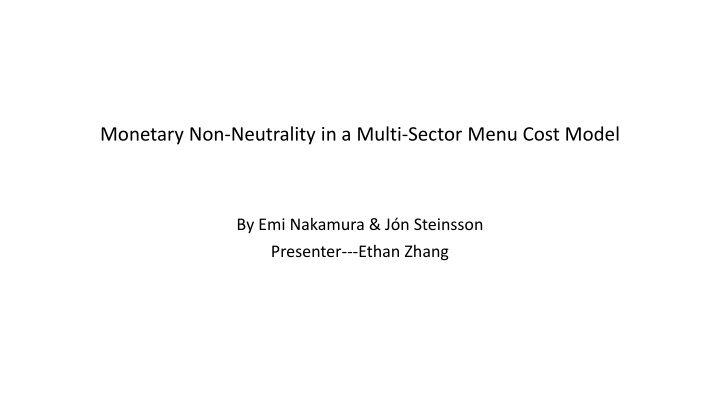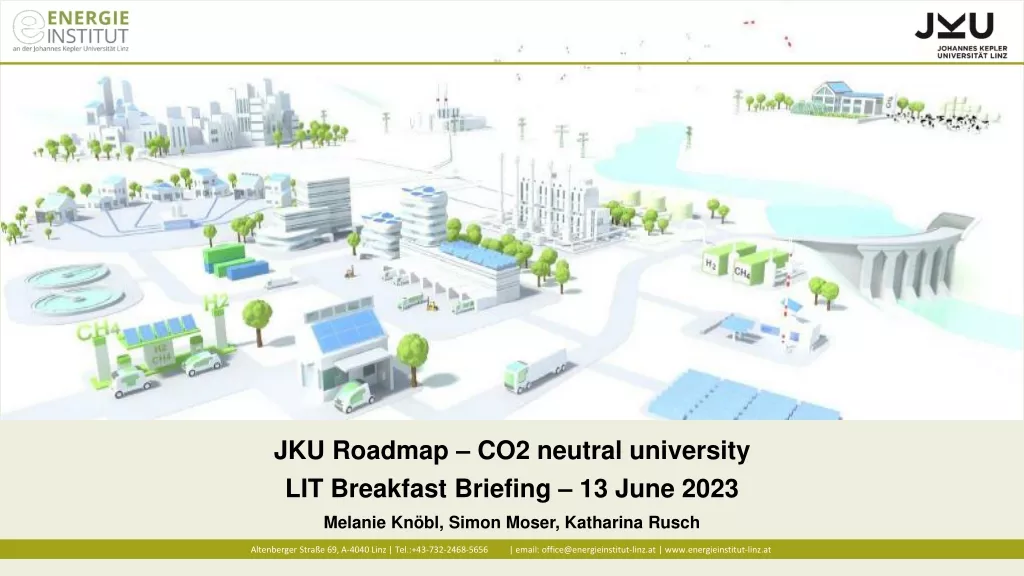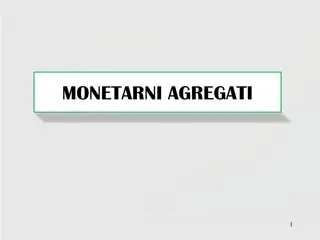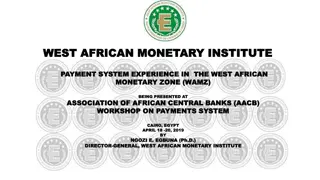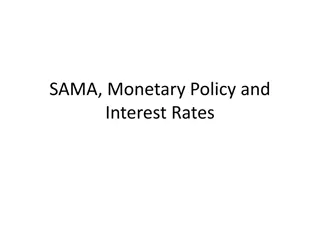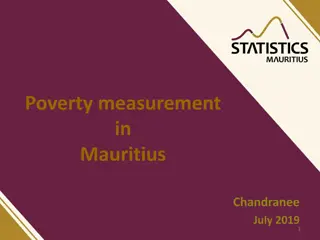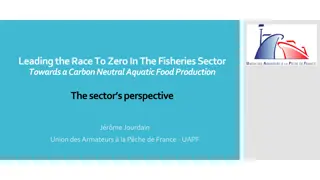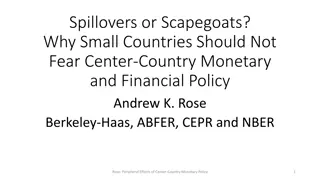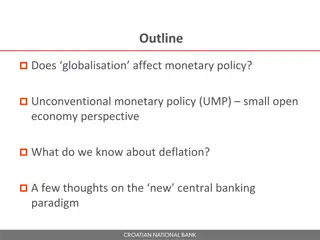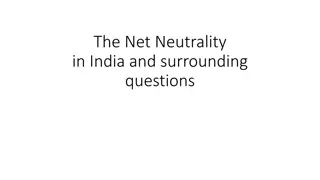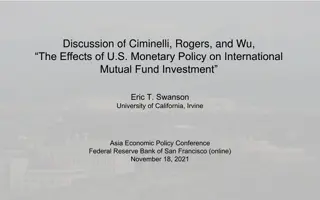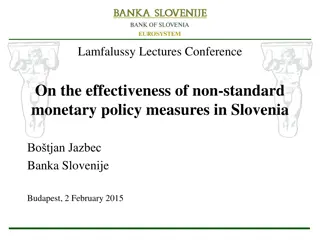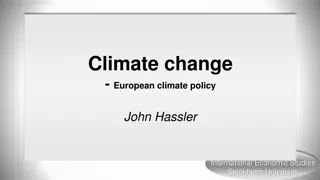Monetary Non-Neutrality in Multi-Sector Menu Cost Model
The dynamics of monetary economics and the impact of menu costs on price rigidity. The multi-sector model delves into firm behavior, household demand, and the role of money non-neutrality in the economy.
Download Presentation

Please find below an Image/Link to download the presentation.
The content on the website is provided AS IS for your information and personal use only. It may not be sold, licensed, or shared on other websites without obtaining consent from the author.If you encounter any issues during the download, it is possible that the publisher has removed the file from their server.
You are allowed to download the files provided on this website for personal or commercial use, subject to the condition that they are used lawfully. All files are the property of their respective owners.
The content on the website is provided AS IS for your information and personal use only. It may not be sold, licensed, or shared on other websites without obtaining consent from the author.
E N D
Presentation Transcript
Monetary Non-Neutrality in a Multi-Sector Menu Cost Model By Emi Nakamura & J n Steinsson Presenter---Ethan Zhang
The Dynamics of Monetary Economics Representative agent model---price adjusts immediately, so money is neutral. NKPC Price rigidity, monetary policy is effective under some circumstances 1. Calvo s Fairy---only a random proportion of the firms can change prices at one time(time-dependent). Golosov and Lucas (2007)--- Empirically Menu cost is very small; not enough to generate meaningful price rigidity in a standard NKPC model. 2. Menu cost--- firms only adjust prices when it is profitable. But Why ? Nakamura&Steinsson(2008)---Menu cost is small. However, if we divide the production industry into heterogenous sectors, and make firms buy from each other for intermediate inputs, money can be shown as non-neutral(today s presentation). Ethan s potential research direction and some critiques
Structure of the presentation Part One---Describe the multi-sector menu cost model Part Two---Critique the paper and suggest some research directions Part Three---Analyze why the model can generate additional money non-neutrality
Model---Household Multi-sector generalization of the model presented by Golosov and Lucas (2007) in which firms use intermediate inputs as well as labor as a factor of production. Consumer maximizes the following equation 1 ? ?+1 1 ? ?? ?? ?=0 1 ???+? ? + 1??+? Households consume a continuum of differentiated products indexed by z ? 1 ? 1 ? 1 ? ?? ??= ??(?) 0 denotes the elasticity of substitution between the differentiated goods. When are the goods perfect substitute?
Household Demand If we minimize the expenditure for buying certain ??,the demand for good z is then ? ??(?) ?? ??(?) = ?? 1 1??(?)1 ??? 1 6, and ????is the minimum cost for which the household can purchase In which ??= 0 the amount ?? of the composite consumption good. The budget constraint of the households is 1 ????+ ????,?+1??+1 ??+ ????+ ?(?)?? 0 Why is there an expectation sign on the lefthand side? The FOC s are ??? ??,?= ?? ??? ?? ?? ?? ?? ??? ? = ???
Firms There are a continuum of firms in the economy indexed by z. Each firm belongs to one of J sectors and specializes in the production of a differentiated product. The production function of firm z is given by ??(?) = ??(?)??(?)1 ????(?)?? ? ? 1 ? ?? ? 1, where ???,? denotes the quantity of the 1???,? in which ??(?) = 0 ? intermediate input used by firm z. log??(?) = ?log?? 1(?) + ??(?). ??? ,the variance of firm s idiosyncratic shocks are sector specific. Firms maximize ?? ?=0??,?+? ?+?(?), where ?? = ??? ??? ????? ????? ??????? ??? ??? is an indicator variable equal to one if the firm changes its price in period t and zero otherwise. Firms must hire an additional ?? units of labor if they decide to change their prices in period t.
Total Demand Cost minimization implies that the firm z s demand for differentiated product ? is ? ??? ?? ???,? = ??(?) ?, so the total demand is ??(?) ?? Recall consumer s demand for product ? is ??(?) = ?? ? ??(?) ?? ??(?) = ?? 1??? ??. The variable ??reflects value-added output while In which ??= ??+ 0 ??reflects gross output. Which one is a more accurate measure of GDP?
Monetary Authority The monetary authority targets a path for the nominal output, ??= ????. The nominal output follow a random walk with drift log??= ? + log?? 1+ ?? ?? ?? Firms perceive that model is solved on a grid for log( What is wrong with this? ?? 1= . is a step function, since the ?? ?? 1). ?? 1
Solving the model firm z s optimization problem may be written recursively in the form of the Bellman equation ? ??(?),?? 1(?) ,?? ?? ? ??+1(?),??(?) ,??+1 ??+1 ? ?(?) + ????,?+1 = ??? ??(?) ? ?? ??+1 1)Specify a finite grid of points for the state variables, ??? ,?? 1? , and ??/?? 1 ?? ?? 2) Propose a function ?? 1on the grid. 3) Given the proposed , solve for the firm s policy function F by value function iteration on the grid 4). Calculate the stationary distribution of the economy over (A(z), p(z)/P, S/P) implied by and F . Calculate P and the price index implied by , and check whether |P P| < . If not, update and go back to step 3
How is this model different from the traditional NKPC model? 1. There are multiple sectors, each with a different price change frequency. 2. Firms buy from each other for inputs. This is called strategic complementarity. 3. log??= ? + log?? 1+ ?? replaces the Taylor rule, and expected inflation becomes ??= ?? 1 4. With one and two, the model can make money more non-neutral comparing to the vanilla menu cost model(I will explain THISin Part Three). ?? ?? 1
Part Two---Critiques and Research Directions The traditional rational-expectations model of inflation and inflation expectations has been a useful workhorse for thinking about issues of credibility and institutional design, but, to my mind, it is less helpful for thinking about economies in which (1) the structure of the economy is constantly evolving in ways that are imperfectly understood by both the public and policymakers and (2) the policymakers objective function is not fully known by private agents. ---Ben Bernanke
Critique 1---What exactly is ?? in the paper? ??= ???? is the aggregate nominal GDP of an economy. To say the central bank can control ??, the authors basically argue that the central bank can control the national nominal GDP. However, obviously the monetary authority can not control the nominal GDP, nor can agents presciently observe this value of nominal GDP in the beginning of a period. The monetary authority can only control the amount of money they release in an economy, and that s the only thing agents can observe in the beginning of a period. So what agents can see in the beginning of a period should be ??, and the right formulation should be ??= ?(??), in which the function f also includes the speed of transaction, the amount of reserves commercial banks deposit in the Fed and etc. Therefore, to respect reality, we need to change ?? ?? ?? 1 ?? 1 into
Does still work if we change ?? into ?? ? The paper claims ?? 1 is very close to the empirical but like argued before agents can t use ?? to form expectations for ??, so what happens if we replace ?? by ??? In the paper is a one-to-one function, but the same ?? ?? ?? 1. For example, we know ?? was both very large after the 2008 financial crisis and during the pandemic(quantitative easing ). However, the inflation rate after 2008 was persistently low, but on the other hand, the inflation increased very quickly during the pandemics. Also theoretically, let s say the central bank spends ?? in one scenario to purchase bonds from Fannie Mae and Freddie Mac, but in another scenario spends an equal amount of money to buy corporate bonds issued by General motor and General electric. The inflation levels resulted from these two scenarios might likely be different, because GM and GE will produce more goods after receiving the money, but Fannie Mae and Freddie Mac will use the money to finance a lot of second-hand purchases, and the inflation pressure will be higher. ?? ?? ?? 1.This could be true, ?? 1 can lead to different
Critique 2---What Menu Cost? The authors themselves also admit menu costs for some products, such as clothing are zero, because price is adjusted when new products come out. However, with online shopping and digitalization, the cost of changing price is approaching zero for almost all industries. The menu cost approach will no longer be valid. Does that mean money will become completely neutral? I believe money is still non-neutral, but we do need to modify the rational expectation model to reflect that.
Theoretical suggestion for money is not neutral--- How does the single consumer NKPC model explain an Economy with the two sectors below? City Rural Area 1. Agrarian economy--- with low utility 1.Has Money 2. NKPC System 3. Operating at full capacity 2. People have demand for more products 3. However, entrepreneurs don t have money to buy inputs Injecting money =inflation QE: Injecting money Convert the Rural area into city. Double the size of the city economy with no inflation Problem comes from assuming diminishing utility of one agent, and everyone can produce as long as there is demand. Need to have heterogenous agents with different characteristics in the system.
Empirical evidence for money is not neutral --Is China an export-led or inflation-led economy? When trading companies in China sell their products abroad, they need to give the foreign currency to the central bank in exchange for Chinese RMB. Of course, the central bank needs to print more RMB each time this happens. However, the government does not use much of the foreign currency to import things. It normally uses the money to purchase US bonds. Even though the amount of RMB increases, there is no additional goods in the system to make up for that. The system is isomorphic to a scenario in which the government purchases export goods from domestic firms by printing money first, and then uses the goods to trade for US bonds. Step 1 is completely inflationary. Although inflation in China has indeed been very high, if money were neutral, the economy would not grow at all.
How do we show money is not neutral I believe Calvo s intuition that only a certain proportion of the firms in an economy can change price at a time is correct. However, we need to find out why that is the case. E.g. Information friction---Some firms pay attention to macro events but some don t ? Searching and Matching?
Heterogenous agent models have great potential Although I don t think menu cost is the main driving force for money non-neutrality, I really like how Nakamura&Steinsson (2008) divides the economy into several sectors and make companies buy from each other. Just by doing this, the authors are able to increase money non- neutrality by many times. The next step is to create a system in which buyers are also heterogenous, much like the Ayigari model. But before doing that let me first explain how heterogenous producers increase money non-neutrality
Part Three---why the model can generate additional money non-neutrality
Heterogeneous frequency of Price Change The degree of monetary non-neutrality is measured by the variance of real output when the model is simulated with nominal aggregate shocks(Impulse response). The authors group goods with similar price change characteristics(frequency and size) into 6 sectors, 9 sectors and 14. The degree of monetary non-neutrality is sharply increasing in the number of sectors. The 14 sector model generates roughly three times as much monetary non-neutrality as the single-sector model.
Why does heterogeneity amplify the degree of non-neutrality? The degree of monetary non-neutrality in the economy is approximately a weighted average of the monetary non-neutrality in each sector. Monetary non-neutrality is a convex function of the frequency of price change. Weighted average of the monetary non-neutrality from each sector is larger than the monetary non-neutrality generated by the average frequency of price change(Jensen inequality). Why is monetary non-neutrality a convex function of the frequency of price change?
Convexity in the Calvo model In a Calvo model, if the frequency of price change of a firm is high, it means the company gets to change its price a lot within a certain amount of time. However, only the 1stadjustment affects a company s output after a shock. All the ensuing changes are nominal. When the frequency increases from a low level, the additional opportunity of price change is more likely to fall on a firm that has not changed the price yet. However, when the frequency increases from a high level, it is more likely for a firm that has already changed the price to be given this additional opportunity. In the extreme case, when all the firms have already changed their price once, the increase in frequency will have no effect at all. Therefore, monetary neutrality is a convex function of price change frequency in the Calvo model.
Convexity for the multi-sector menu cost model Firms are not selected at random to change their prices in the menu cost model. Instead, the frequency of price change is decided by the profit maximization motive. One reason why sector A may have a lower frequency of price change than sector B is that firms in sector A face larger menu costs than firms in sector B. Another possible reason is that firms in sector A may face smaller idiosyncratic shocks but face menu costs of the same size. Why do small idiosyncratic shocks lead to lower frequency? Nevertheless, with the same idiosyncratic shock, non- neutrality is still a convex function of frequency. Because the first change offsets inflation and subsequent changes offset shocks(similar to Calvo). But if two sectors have the same frequency of price change, but sector A faces smaller idiosyncratic shocks than sector B, then the money non-neutrality generated by sector B is higher. The reason is that sector A gives more weight to the aggregate inflation than the idiosyncratic shocks when they are adjusting the price.
The empirical US non-neutrality curve is convex Critique 3---the logic is a bit fussy here. Don t know if the curve shows the non-neutrality of different sectors or if it is curve of aggregate non-neutrality simulated by different levels of counterfactual idiosyncratic shocks(menu cost). It looks like a curve of counterfactual aggregate frequency, but I think to prove their point we need a curve of different sectors. Anyway, I feel this section is not very clear.
Intermediate Inputs as a Source of Amplification Recall ??(?) = ??(?)??(?)1 ????(?)??. Empirical evidence suggests that the intermediate input share or ??= 0.7 This calibration yields roughly triple the amount of monetary non- neutrality that the model without intermediate inputs does(single sector). But Why?
Answer Firm s marginal costs are a weighted average of the wage the firm faces and the cost of its inputs ???(?) =?? ??(?) Since the prices of other goods in the economy respond sluggishly to an increase in ??when firms face menu costs, the firm s marginal costs rise by less than one-percent in response to a one- percent increase in ?? when ??> 0 Firms that change their price after a shock to ?? choose a lower price than they would if labor was their only input. A Battalion is only as fast as its slowest Company. 1 ???? ?? 1 ???? ??(?) ?? =???
